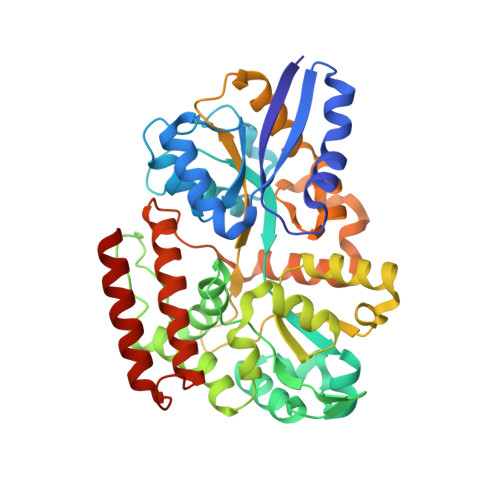Deciphering Cellodextrin and Glucose Uptake in Clostridium thermocellum.
Yan, F., Dong, S., Liu, Y.J., Yao, X., Chen, C., Xiao, Y., Bayer, E.A., Shoham, Y., You, C., Cui, Q., Feng, Y.(2022) mBio 13: e0147622-e0147622
- PubMed: 36069444
- DOI: https://doi.org/10.1128/mbio.01476-22
- Primary Citation of Related Structures:
7X0G, 7X0H, 7X0I, 7X0J, 7X0K, 7X0L, 7X0M, 7X0N, 7X0O, 7X0P, 7X0Q, 7X0R - PubMed Abstract:
Sugar uptake is of great significance in industrially relevant microorganisms. Clostridium thermocellum has extensive potential in lignocellulose biorefineries as an environmentally prominent, thermophilic, cellulolytic bacterium. The bacterium employs five putative ATP-binding cassette transporters which purportedly take up cellulose hydrolysates. Here, we first applied combined genetic manipulations and biophysical titration experiments to decipher the key glucose and cellodextrin transporters. In vivo gene inactivation of each transporter and in vitro calorimetric and nuclear magnetic resonance (NMR) titration of each putative sugar-binding protein with various saccharides supported the conclusion that only transporters A and B play the roles of glucose and cellodextrin transport, respectively. To gain insight into the structural mechanism of the transporter specificities, 11 crystal structures, both alone and in complex with appropriate saccharides, were solved for all 5 putative sugar-binding proteins, thus providing detailed specific interactions between the proteins and the corresponding saccharides. Considering the importance of transporter B as the major cellodextrin transporter, we further identified its cryptic, hitherto unknown ATPase-encoding gene as clo1313_2554 , which is located outside the transporter B gene cluster. The crystal structure of the ATPase was solved, showing that it represents a typical nucleotide-binding domain of the ATP-binding cassette (ABC) transporter. Moreover, we determined that the inducing effect of cellobiose (G2) and cellulose on cellulosome production could be eliminated by deletion of transporter B genes, suggesting the coupling of sugar transport and regulation of cellulosome components. This study provides key basic information on the sugar uptake mechanism of C. thermocellum and will promote rational engineering of the bacterium for industrial application. IMPORTANCE Highly efficient sugar uptake is important to microbial cell factories, and sugar transporters are therefore of great interest in the study of industrially relevant microorganisms. Clostridium thermocellum is a lignocellulolytic bacterium known for its multienzyme complex, the cellulosome, which is of great potential value in lignocellulose biorefinery. In this study, we clarify the function and mechanism of substrate specificity of the five reported putative sugar transporters using genetic, biophysical, and structural methods. Intriguingly, the results showed that only one of them, transporter B, is the major cellodextrin transporter, whereas another, transporter A, represents the major glucose transporter. Considering the importance of transporter B, we further identified the missing ATPase gene of transporter B and revealed the correlation between transporter B and cellulosome production. Revealing the mechanism by which C. thermocellum utilizes cellodextrins will help pave the way for engineering the strain for industrial applications.
Organizational Affiliation:
CAS Key Laboratory of Biofuels, Shandong Provincial Key Laboratory of Synthetic Biology, Qingdao Institute of Bioenergy and Bioprocess Technologygrid.458500.c, Chinese Academy of Sciences, Qingdao, China.





















